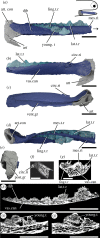Diverse stem-chondrichthyan oral structures and evidence for an independently acquired acanthodid dentition
- PMID: 34804566
- PMCID: PMC8580420
- DOI: 10.1098/rsos.210822
Diverse stem-chondrichthyan oral structures and evidence for an independently acquired acanthodid dentition
Abstract
The teeth of sharks famously form a series of transversely organized files with a conveyor-belt replacement that are borne directly on the jaw cartilages, in contrast to the dermal plate-borne dentition of bony fishes that undergoes site-specific replacement. A major obstacle in understanding how this system evolved is the poorly understood relationships of the earliest chondrichthyans and the profusion of morphologically and terminologically diverse bones, cartilages, splints and whorls that they possess. Here, we use tomographic methods to investigate mandibular structures in several early branching 'acanthodian'-grade stem-chondrichthyans. We show that the dentigerous jaw bones of disparate genera of ischnacanthids are united by a common construction, being growing bones with non-shedding dentition. Mandibular splints, which support the ventro-lateral edge of the Meckel's cartilage in some taxa, are formed from dermal bone and may be an acanthodid synapomorphy. We demonstrate that the teeth of Acanthodopsis are borne directly on the mandibular cartilage and that this taxon is deeply nested within an edentulous radiation, representing an unexpected independent origin of teeth. Many or even all of the range of unusual oral structures may be apomorphic, but they should nonetheless be considered when building hypotheses of tooth and jaw evolution, both in chondrichthyans and more broadly.
Keywords: Palaeozoic; acanthodians; chondrichthyans; dentitions; early vertebrates; tooth evolution.
© 2021 The Authors.
Figures








Similar articles
-
Acanthodian dental development and the origin of gnathostome dentitions.Nat Ecol Evol. 2021 Jul;5(7):919-926. doi: 10.1038/s41559-021-01458-4. Epub 2021 May 6. Nat Ecol Evol. 2021. PMID: 33958756
-
Dental patterning in the earliest sharks: Implications for tooth evolution.J Morphol. 2014 May;275(5):586-96. doi: 10.1002/jmor.20242. Epub 2013 Dec 18. J Morphol. 2014. PMID: 24347366
-
First shark from the Late Devonian (Frasnian) Gogo Formation, Western Australia sheds new light on the development of tessellated calcified cartilage.PLoS One. 2015 May 28;10(5):e0126066. doi: 10.1371/journal.pone.0126066. eCollection 2015. PLoS One. 2015. PMID: 26020788 Free PMC article.
-
Origin and evolution of gnathostome dentitions: a question of teeth and pharyngeal denticles in placoderms.Biol Rev Camb Philos Soc. 2005 May;80(2):303-45. doi: 10.1017/s1464793104006682. Biol Rev Camb Philos Soc. 2005. PMID: 15921053 Review.
-
Architectural and ultrastructural features of tessellated calcified cartilage in modern and extinct chondrichthyan fishes.J Fish Biol. 2021 Apr;98(4):919-941. doi: 10.1111/jfb.14376. Epub 2020 Jul 1. J Fish Biol. 2021. PMID: 32388865 Review.
Cited by
-
The oldest gnathostome teeth.Nature. 2022 Sep;609(7929):964-968. doi: 10.1038/s41586-022-05166-2. Epub 2022 Sep 28. Nature. 2022. PMID: 36171375
-
The skeletal completeness of the Palaeozoic chondrichthyan fossil record.R Soc Open Sci. 2024 Jan 31;11(1):231451. doi: 10.1098/rsos.231451. eCollection 2024 Jan. R Soc Open Sci. 2024. PMID: 38298400 Free PMC article.
References
-
- Ørvig T. 1980. Histologic studies of ostracoderms, placoderms and fossil elasmobranchs: 3. Structure and growth of the gnathalia of certain arthrodires. Zool. Scr. 9, 141-159. (10.1111/j.1463-6409.1980.tb00660.x) - DOI
Associated data
LinkOut - more resources
Full Text Sources

